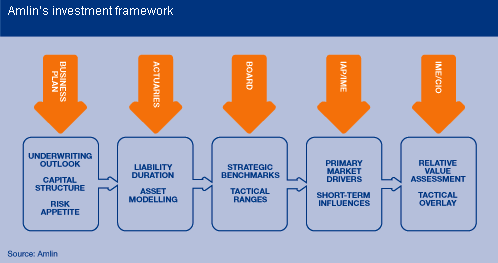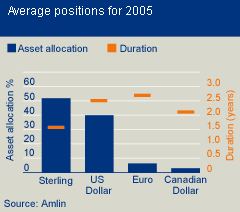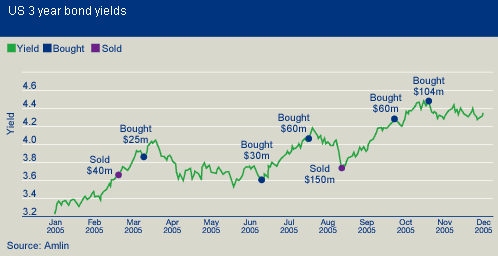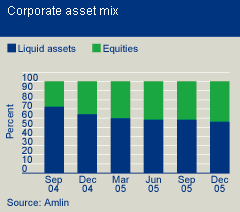Investment management
Amlin's second source of profit after underwriting comes from return on its investments. Our approach is consistent with our underwriting based on experience, diversity, risk management and management of market cycles.
We have in recent years invested in our investment management competencies recruiting a Chief Investment Officer in 2003 and building a new investment framework which includes market experts
as a sounding board for investment management decisions.
For the purposes of deciding investment strategy we divide the Group's investments into two distinct parts: first Group capital which supports the underwriting business and second, policyholders' funds where premiums are received in advance of claim settlement.
The investment strategy of each part is then driven by the returns available on particular asset classesfor a given level of modelled investment risk. The strategies determined are distinct because the level of risk that we are prepared to accept for each partis different.

For policyholders' funds we have a relatively low risk appetite. The aim is to match liability currency and duration with assets. This leads us to invest in highly liquid short term bonds and cash.
During 2005 the average duration of assets and currency mix for policyholders' funds is set out in
the table below.

Tactical investments decisions are taken around the core asset benchmark. For example, if bonds look expensive we are prepared to sell and hold cash as an alternative within pre defined ranges.
This approach has continued to add value as illustrated in the following chart:
From a currency perspective, for Syndicate 2001, we sell trading currency profits (which are predominantly US dollar, Canadian dollar and Euros) into sterling to mitigate the impact of fluctuating exchange rates.
Amlin Bermuda holds its assets in US$ and trades predominantly in that currency. As the Group's Bermuda operations grow and become a more material part of trading activities, it will be necessary
to reconsider the Group's presentational currency.

For the Group's capital the investment horizon is longer term and this allows investment in more volatile asset classes, such as longer duration bonds and equities. A value at risk (VaR) asset model is used to determine the most efficient benchmark for our solvency capital.
During the year, excluding Amlin Bermuda, the asset mix changed as follows.

The increase in equities from September 2004 was a strategic decision taken to increase our investment risk. At this point, with underwriting markets becoming more competitive, the balance sheet growing and debt leverage reducing, we wanted to increase our exposure to equities, and stock market conditions appeared supportive. During 2005 our average equity to bond/cash ratio was 41% compared to 26% in 2004.
Estimation of outstanding liabilities
The estimation of outstanding claims that the Group has to settle is a vital element of overall management of the balance sheet. It is a major factor in determining profitability and also knocks
on to investment management, as very different approaches are adopted for capital assets and policyholders' funds.
By its nature insurance is an uncertain business and much of Amlin's business is large commercial insurance which can be volatile.The subjectivities that we have to deal with when considering the level of outstanding liabilities include the risk profile of an insurance policy, class of business, timeliness of notification of claims, validity of the claims made against the policy and validity of the quantum of the claim. At any time, there are a range of possible outcomes that the Group faces when considering the population of claims that remain to be settled.
Therefore we believe that it is appropriate to adopt a cautious stance to the assessment of liabilities. Consequently reserves carried are in excess of a best estimate of the likely outcome. As time passes the level of caution in respect of an underwriting year is reduced to reflect the greater certainty that is reached. However it should be noted that individual claims may remain highly subjective until a final settlement is made.
Further details on the reserving process are provided here.
|